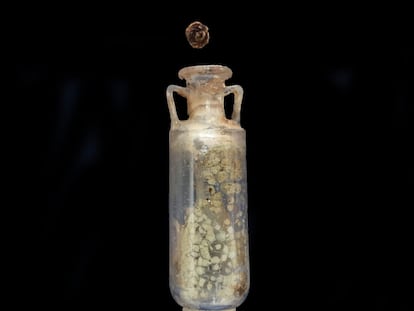Memories, disgust and the desire to shop: The amazing powers of human smell
Although we only pay attention to particularly strong smells, people are able to detect — even subconsciously — the very subtle odors that alter our behavior

When our primitive ancestors rose on their legs and ceased to be quadrupeds, the telesenses (sight and hearing) — crucial for perceiving events taking place in the distance — prevailed over the proximal senses (taste and smell). This is because the former were more closely related to survival, eating and avoiding dangers. But, far from perishing, ancestral chemical senses continue to form an essential part of our nature. Although we don’t realize it, humans today still have a very powerful sense of smell.
Between two Olympic-size swimming pools filled with water, a human can detect (by smell) the one that contains dissolved droplets of the odorant mercaptan. This product is usually added to propane gas, to identify its presence and to be able to detect it when it leaks. We can also distinguish two odors that differ by only 7% in their concentration. And, from smell alone, we can tell if a t-shirt that was worn 24 hours ago was worn by us, or by someone else.
A father or mother can distinguish the smell of their baby from that of another baby. Due to their specific body odor, we can detect the partner that best matches us genetically. Thus, if a woman smells the shirts worn by various men, the shirt of the man with whom the probability of having a child with a disease would be less likely (for reasons of genetic incompatibility) may be more pleasant to her. Of course, sniffing T-shirts isn’t how we choose a mate, but the test works. Long ago, it must have played an important role in the evolution of animals.
Although we often have difficulty knowing where a smell comes from, by moving our head or body, we can quickly locate the object that smells. We can even learn to follow a scent trail in a field, although not as well as many animals. Despite having this great olfactory sensitivity, we only pay attention to what smells a lot, paying little attention to what barely smells, even though we’re also evolved enough to identify it.
Generally, we underestimate our own olfactory capacity — except, of course, when the smell is unpleasant and annoying, because we pay more attention to bad smells. Perfume shop assistants or wine tasters improve their sense of smell with practice. The sense of smell also improves when we haven’t eaten for a long time, because, when we’re hungry, the cells of the stomach walls secrete a special hormone — ghrelin — which travels through the blood. Ghrelin reaches the brain where, in addition to activating the neural circuits of hunger in the hypothalamus, it also stimulates exploration through sniffing and increases olfactory sensitivity. All of this helps us all locate, identify and choose foods.
Imagine if we were commissioned to classify fruits according to their smell. What smell would we classify an orange as having? And what about a melon or a banana? If we had several fruits that we needed to classify by their smell, it’s most likely that we would end up labelling as many boxes as there are different fruits. While we can detect thousands of different smells, we don’t have names for each one of them… Actually, for any of them. Smell is the only sense for whose multiple experiences we don’t have specific names, as we do for colors (red, green, yellow, etc.) or tastes (salty, sweet, etc.). Precisely describing a smell is difficult. In the best case scenario, we end up saying that something smells like something else: this smells like roses, this smells of wet earth, that thing over there smells like it’s burning, etc.
On top of this difficulty, most of the smells that we perceive aren’t simple, but are rather mixtures of many other smells. For example, in a broth, there can be dozens of different odorants. However, the perception of odor in humans is so synthetic that even a trained oenologist isn’t capable of perceiving more than three components of a mixture. Can you imagine the enormous vocabulary that we would need to name all the thousands of smells that we’re capable of perceiving?
Nameless odors
If we don’t have names for smells, it’s because smell isn’t an analytical sense. That is, it hasn’t evolved enough so that we know the characteristics and precise details of the things that we smell. For that, most of us have other senses, such as sight. Smell has evolved to, simply, identify the things we smell; that is, so that we take measures such as not eating something that smells off, or searching for where the scent of fire is coming from. No known attempt to name odors has been successful. Even the best of such classifications leaves out many odors.
On the other hand, common knowledge suggests that women of all ages tend to identify odors better than men — of course, as long as they aren’t smokers, because smokers, either male or female, have a worse sense of smell than non-smokers. However, what isn’t true, although many people believe it, is that pregnant women have more olfactory sensitivity. There’s no scientific proof of this. What does seem to change during gestation are the sensations that come from smells. For instance, this results in pregnant women developing a sudden aversion to the familiar odors of certain foods.
When a pregnant woman rejects certain odors, she may believe that she’s more sensitive to them, when, in fact, she’s not. She simply doesn’t like the smell. It has also been found that the smells and tastes of a mother’s diet during gestation, as well as the mother’s own distinctive smell, influence the preferences and perceptions of her babies once they’re born. Odorants in amniotic fluid and breast milk can exert influence, perhaps altering the organization of a fetus’s or newborn’s developing olfactory brain.
Stranger is what happens on occasions when, as if by magic, we go from a normal state to a certain state of euphoria or, conversely, to a feeling of discomfort or anger, without knowing why. We now know that, among other possible causes, these sudden changes may be caused by environmental odorants, even when their concentration in the surrounding air is so low that we cannot consciously perceive them. We don’t smell anything, but the smells can still change our mood.
Indeed, it has been shown that even if we’re not aware of it, some subliminal olfactory stimuli have the surprising capacity to affect mood, social judgments, the assessments we make of things, or commercial consumption. As neuromarketing specialists well know, unpleasant odors, even when unconsciously perceived, can worsen moods and induce anxiety in people. In fact, it has been proven that dispersing a pleasant orange aroma in a dentist’s waiting room improves the mood of certain patients, but only women, not men. Perhaps this is due to the greater olfactory sensitivity of the former.
From moods to consumption
The social influence of odors has been best-verified in the world of commerce. It’s been proven that the dispersion of a pleasant odorant in a shopping center not only positively increases the perception of shoppers, but also increases the amount of money spent (especially by young people), as well as the memory and appreciation of the place that people have left. Something similar can be verified in restaurants, in relation to the time spent and the money spent. Certain odors can also increase the sums gambled away in casinos. Notably, in most of these cases, conscious perception of odors wasn’t even necessary. A subliminal infusion was enough — that is, a low concentration of the odorant.
Who hasn’t relived emotions and situations from early childhood by opening an old trunk and receiving the smelly impact of old toys, clothes and other objects? Smells evoke childhood memories better than any other sense, particularly from the first ten years of life. The writer Marcel Proust made his own experience popular by recounting how eating a tea-soaked cupcake brought back powerful memories of his childhood. In his case, it wasn’t only because he tasted the cake in his mouth, but also because its smell stimulated the receptors in his nostrils internally — from the pharynx — due to retronasal olfactory stimulation, which completes the sense of taste and results in flavor.
More than any other sense, smell takes us back to the remote past, vividly creating the sensation of being there, of reliving it intensely. Natural selection, like an unstoppable and eager sculptor, has made possible the evolution of all the olfactory capacities that we have. Multiple and rigid connections are established between the neurons and the brain circuits that process smell, emotion and memory.
When we refer to food, we talk about aromas; when we discuss perfumes, we mention fragrances — a word that comes from the Latin per fumum (a smell obtained through the smoke that is released when something burns). Recently, in a Roman funerary complex in Carmona, a town in southwestern Spain, an old bottle was found containing what is supposed to be a perfume used by the ancient Romans — an oil of Indian origin known as patchouli, which is still used in perfumery today.
Could Julius Caesar have used that perfume to woo Cleopatra? If there are things that have changed relatively little in the last millennia — and even over the course of evolution — the sense of smell is certainly among them.
Sign up for our weekly newsletter to get more English-language news coverage from EL PAÍS USA Edition
Tu suscripción se está usando en otro dispositivo
¿Quieres añadir otro usuario a tu suscripción?
Si continúas leyendo en este dispositivo, no se podrá leer en el otro.
FlechaTu suscripción se está usando en otro dispositivo y solo puedes acceder a EL PAÍS desde un dispositivo a la vez.
Si quieres compartir tu cuenta, cambia tu suscripción a la modalidad Premium, así podrás añadir otro usuario. Cada uno accederá con su propia cuenta de email, lo que os permitirá personalizar vuestra experiencia en EL PAÍS.
¿Tienes una suscripción de empresa? Accede aquí para contratar más cuentas.
En el caso de no saber quién está usando tu cuenta, te recomendamos cambiar tu contraseña aquí.
Si decides continuar compartiendo tu cuenta, este mensaje se mostrará en tu dispositivo y en el de la otra persona que está usando tu cuenta de forma indefinida, afectando a tu experiencia de lectura. Puedes consultar aquí los términos y condiciones de la suscripción digital.
More information
Últimas noticias
Trump claims peace in Ukraine is near, but Moscow suggests otherwise
A survivor’s account of the Interoceanic Train accident: ‘We were scared because of the speed on the curve’
The Interoceanic Train, the Mexican alternative to the Panama Canal
What is known about the Interoceanic Train derailment in Oaxaca
Most viewed
- Oona Chaplin: ‘I told James Cameron that I was living in a treehouse and starting a permaculture project with a friend’
- Reinhard Genzel, Nobel laureate in physics: ‘One-minute videos will never give you the truth’
- Why the price of coffee has skyrocketed: from Brazilian plantations to specialty coffee houses
- Pablo Escobar’s hippos: A serious environmental problem, 40 years on
- Chevy Chase, the beloved comedian who was a monster off camera: ‘Not everyone hated him, just the people who’ve worked with him’











































